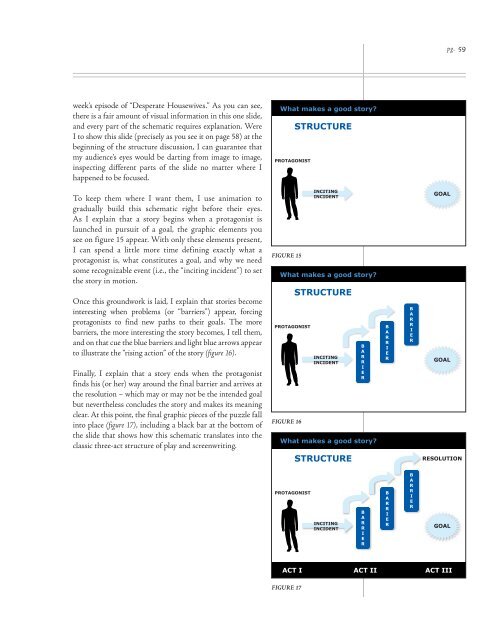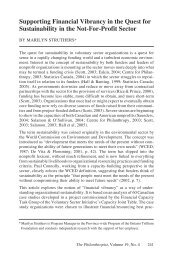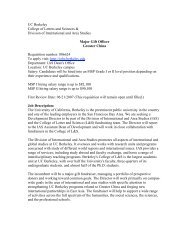Why Bad Presentations Happen to Good Causes - The Goodman ...
Why Bad Presentations Happen to Good Causes - The Goodman ...
Why Bad Presentations Happen to Good Causes - The Goodman ...
You also want an ePaper? Increase the reach of your titles
YUMPU automatically turns print PDFs into web optimized ePapers that Google loves.
week’s episode of “Desperate Housewives.” As you can see,<br />
there is a fair amount of visual information in this one slide,<br />
and every part of the schematic requires explanation. Were<br />
I <strong>to</strong> show this slide (precisely as you see it on page 58) at the<br />
beginning of the structure discussion, I can guarantee that<br />
my audience’s eyes would be darting from image <strong>to</strong> image,<br />
inspecting different parts of the slide no matter where I<br />
happened <strong>to</strong> be focused.<br />
To keep them where I want them, I use animation <strong>to</strong><br />
gradually build this schematic right before their eyes.<br />
As I explain that a s<strong>to</strong>ry begins when a protagonist is<br />
launched in pursuit of a goal, the graphic elements you<br />
see on figure 15 appear. With only these elements present,<br />
I can spend a little more time defining exactly what a<br />
protagonist is, what constitutes a goal, and why we need<br />
some recognizable event (i.e., the “inciting incident”) <strong>to</strong> set<br />
the s<strong>to</strong>ry in motion.<br />
Once this groundwork is laid, I explain that s<strong>to</strong>ries become<br />
interesting when problems (or “barriers”) appear, forcing<br />
protagonists <strong>to</strong> find new paths <strong>to</strong> their goals. <strong>The</strong> more<br />
barriers, the more interesting the s<strong>to</strong>ry becomes, I tell them,<br />
and on that cue the blue barriers and light blue arrows appear<br />
<strong>to</strong> illustrate the “rising action” of the s<strong>to</strong>ry (figure 16).<br />
Finally, I explain that a s<strong>to</strong>ry ends when the protagonist<br />
finds his (or her) way around the final barrier and arrives at<br />
the resolution – which may or may not be the intended goal<br />
but nevertheless concludes the s<strong>to</strong>ry and makes its meaning<br />
clear. At this point, the final graphic pieces of the puzzle fall<br />
in<strong>to</strong> place (figure 17), including a black bar at the bot<strong>to</strong>m of<br />
the slide that shows how this schematic translates in<strong>to</strong> the<br />
classic three-act structure of play and screenwriting.<br />
What makes a good s<strong>to</strong>ry?<br />
PROTAGONIST<br />
FIGURE 15<br />
STRUCTURE<br />
INCITING<br />
INCIDENT<br />
What makes a good s<strong>to</strong>ry?<br />
PROTAGONIST<br />
FIGURE 16<br />
STRUCTURE<br />
INCITING<br />
INCIDENT<br />
B<br />
A<br />
R<br />
R<br />
I<br />
E<br />
R<br />
What makes a good s<strong>to</strong>ry?<br />
PROTAGONIST<br />
STRUCTURE<br />
INCITING<br />
INCIDENT<br />
B<br />
A<br />
R<br />
R<br />
I<br />
E<br />
R<br />
B<br />
A<br />
R<br />
R<br />
I<br />
E<br />
R<br />
B<br />
A<br />
R<br />
R<br />
I<br />
E<br />
R<br />
GOAL<br />
GOAL<br />
GOAL<br />
pg. 59<br />
RESOLUTION<br />
ACT I ACT II ACT III<br />
FIGURE 17<br />
B<br />
A<br />
R<br />
R<br />
I<br />
E<br />
R<br />
B<br />
A<br />
R<br />
R<br />
I<br />
E<br />
R













